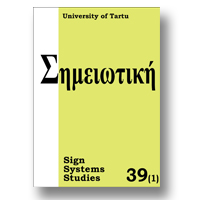|
|
|
21.
|
Sign Systems Studies:
Volume >
48 >
Issue: 1
Dorthe Duncker
Chatting with chatbots:
Sign making in text-based human-computer interaction
abstract |
view |
rights & permissions
| cited by
This paper investigates the kind of sign making that goes on in text-based human–computer interaction, between human users and chatbots, from the point of view of integrational linguistics. A chatbot serves as a “conversational” user interface, allowing users to control computer programs in “natural language”. From the user’s perspective, the interaction is a case of semiologically integrated activity, but even if the textual traces of a chat may look like a written conversation between two humans the correspondence is not one-to-one. It is argued that chatbots cannot engage in communication processes, although they may display communicative behaviour. They presuppose a (second-order) language model, they can only communicate at the level of sentences, not utterances, and they implement communicational sequels by selecting from an inventory of executable skills. Instead of seeing them as interlocutors in silico, chatbots should be seen as powerful devices for humans to make signs with.
|
|
|
|
|
|
|
22.
|
Sign Systems Studies:
Volume >
48 >
Issue: 1
Chris Barnham
Hegel and the Peircean ‘object’
abstract |
view |
rights & permissions
| cited by
Peirce’s semiotics is well known for advocating a triadic, rather than a dyadic, sign structure, but interpretations of how such a structure works in practice have varied considerably. This paper argues that the Peircean ‘object’ is central to understanding Peirce’s philosophical intent and that this element should be construed as a mediating element within the sign rather than as an originating source of it. This interpretation resonates with the fundamentally anti-dualist character of Peirce’s philosophy and it creates potential convergences with the medieval philosophy of Duns Scotus – which was so influential in Peirce’s thinking. Moreover, construal of the ‘object’ as a mediating entity within the sign highlights important parallels with Hegelian thought and the role of the ‘essence’ in the latter’s dialectics. It is argued, indeed, that Peirce’s triadic template for the sign has strong Hegelian roots. This substantially repositions Peirce’s semiotics; it becomes, as in Hegel’s dialectics, an account of concept formation. The over-arching framework in which this takes place, however, retains an adherence to Peirce’s empiricist background and so avoids the reliance on logic which is the defining characteristic of Hegel’s dialectical method.
|
|
|
|
|
|
|
23.
|
Sign Systems Studies:
Volume >
48 >
Issue: 1
Adrian Pablé
Integrating biosemiotics:
From a semiological point of view
abstract |
view |
rights & permissions
| cited by
This paper is a study in the ‘philosophy of semiotics’. It is centred on a critical approach to the Peircean sign conception, which underlies biosemiotics and the global perspective on signs. The present discussion tackles questions of ontological and epistemological interest, which it does by taking a distinctly semiological point of reference. The semiology which the present critique draws inspiration from is Roy Harris’ integrationism, an approach to human communication which rejects Saussurean semiology – the common target of Peircean semiotics. Integrationism explains signs in relation to human activities. It shares with biosemiotics a view of reality as species-specific, but takes a skeptical position towards the investigation of non-human signs on the grounds that it implies a metalanguage impervious to the radical indeterminacy of the sign. Integrationists take this indeterminacy as the starting point for their reflections on human communication.
|
|
|
|
|
|
|
24.
|
Sign Systems Studies:
Volume >
48 >
Issue: 1
Johan Siebers
Philosophy as communication theory
abstract |
view |
rights & permissions
| cited by
There has been comparatively little attention for the fundamental ontology of communication in recent philosophy. Nevertheless, from classical metaphysical accounts of relationality and communal being to the analysis of intersubjectivity in phenomenology and to concrete existence as understood by process philosophy, the communicative structure of the act of being has been, if not explicitly then implicitly, a perennial component of metaphysical reflection. Communication theory can be conceived in such a way that it takes this ontological dimension into account. The ramifications of connecting being to communication in this way are explored in discussion with the conceptualizations of communication in integrationism and biosemiotics. An interpretation of Gabriel Marcel’s existential analysis of “my life” is used to show what philosophy as communication theory (in the strong sense of the notion elaborated here) might look like.
|
|
|
|
|
|
|
25.
|
Sign Systems Studies:
Volume >
48 >
Issue: 1
Paul Cobley
“Who goes there?” Reflections on signs and personhood in Christopher Hutton’s Integrationism and the Self
view |
rights & permissions
| cited by
|
|
|
|
